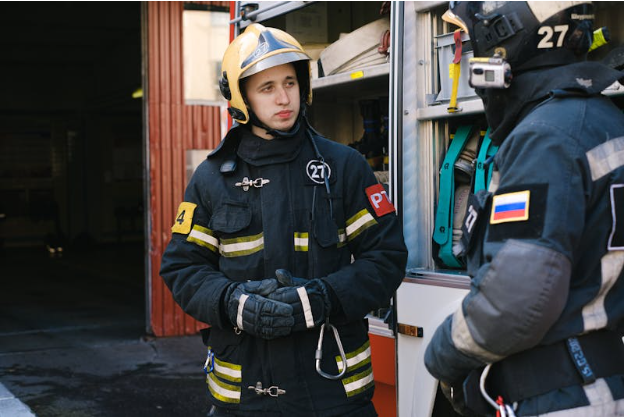3 Technologies That Are Helping Firefighters Save Lives More Efficiently

Battling the infernos is not easy. It takes a lot of courage to risk your own life and save others from the burning fire. But firefighters do this every day—no wonder they are the unsung heroes of our society.
For centuries, these brave individuals have fought fires with traditional tools like archaic pumps and fire buckets and courage. But, thankfully, the way firefighters battle blazes is transforming—all thanks to technology.
Advancements in technology have led to the emergence of cutting-edge solutions that allow firefighters to tackle even the most challenging infernos efficiently.
Want to know which technologies are helping firefighters save peoples’ lives more efficiently? This guide is for you. We’ll discuss a few innovations that are revolutionizing firefighting operations while improving firefighters’ safety.
1 Firefighter Helmets With Visors
Firefighters wear helmets to protect their heads from debris, falling objects, and cinders. But traditional helmets don’t do much to protect them from the blazing heat emitted by infernos.
Newer helmets, nonetheless, feature visors that can withstand intense heat. Such helmets will safeguard your head and face from intense heat alongside unforeseen impacts.
Firefighter helmets that block heat are made from heat-resistant materials. Typically, thermoplastics and fiberglass are used to ensure you’re shielded from heat, smoke, and debris during firefighting operations.
Guardian, a Milwaukee-based helmet maker and Scott Safety, a respiratory protection equipment company, are to thank for this newest innovation. The engineers of both companies collaborated to develop a device that would function with all the helmets of the Guardian without interfering with communication equipment pre-installed in some models.
Interestingly, these helmets can tolerate temperatures as high as 1,700 degrees Fahrenheit. Hence, buy one for yourself before you set out on the next firefighting operation.
2 NASA Firefighting Suits
In the realm of firefighting, NASA deserves praise for developing suits for firefighters that can withstand extreme temperatures and provide maximum protection. Since most of the problems that firefighters face are similar to those encountered by astronauts, NASA used the Space suit technology to design their suits.
NASA’s recent firefighting suits feature a blend of Kevlar and PBI. These suits can withstand the heat of a blow torch while still absorbing 67 pounds of force before tearing.
Then, there are NASA prototype suits. These are made of fabric called poly-phenylene benzobisoxazole/Kevlar. These suits are three times stronger than the PBI/Kevlar blend. Prototype suits will offer more protection from fire and hazardous materials than the other two.
As a firefighter, you must wear prototype suits to firefighting operations. That is because you’re exposed to various toxins on the fireground. It might be hard to believe, but many of them are carcinogenic.
One cancer-causing substance that has been a matter of concern is per- and polyfluoroalkyl substances, especially perfluorooctane sulfonate (PFOS). Firefighters are exposed to PFOS through the aqueous film-forming foam (AFFF). Common pathways of PFOS exposure for firefighters are inhalation, ingestion, or dermal absorption.
A new study analyzed 1,060 Air Force servicemen’s blood serum. The findings revealed that those with higher exposure to PFOS were more likely to acquire testicular cancer.
More than a hundred firefighters who developed cancer are seeking compensation from the AFFF manufacturers. Military firefighters are also claiming VA disability compensation. To be eligible for VA benefits, TorHoerman Law explains, you must have been on active duty in the military.
Before you file VA claims for exposure to AFFF, it’s essential to find out if you qualify for it. Consider seeking advice from a lawyer experienced in handling VA claims. They will help you assess whether you are eligible for VA claims and help you navigate the complexities of the process if you are.
In a nutshell, go for a prototype suit. PFOS will not come into contact with your skin, which will reduce your risk of cancer.
Read also: 3 Technologies That Are Helping Firefighters Save Lives More Efficiently
3 Drones
Drones have soared beyond their recreational and commercial applications and have become indispensable tools for firefighters.
These devices—equipped with high-resolution cameras and thermal imaging capabilities—serve as eyes in the sky for firefighters. Drones help detect animals as well as people who must be rescued from the fireground. They also provide valuable aerial support, allowing firefighters to assess the extent of the fire before they begin with firefighting operations.
Drones can also reach tight spaces. In case of a fire outbreak, they can be deployed to navigate through narrow corridors, stairwells, and other confined areas that may be too dangerous or impractical for firefighters to enter.
To sum up, technology is revolutionizing the way firefighters combat blazes and save lives. Be it helmets with visors, NASA firefighting suits, or drones, these innovations are making firefighters more efficient in their operations while ensuring their safety. As technology continues to evolve, we will witness more innovations that will improve operational efficiency and the safety of firefighters.



